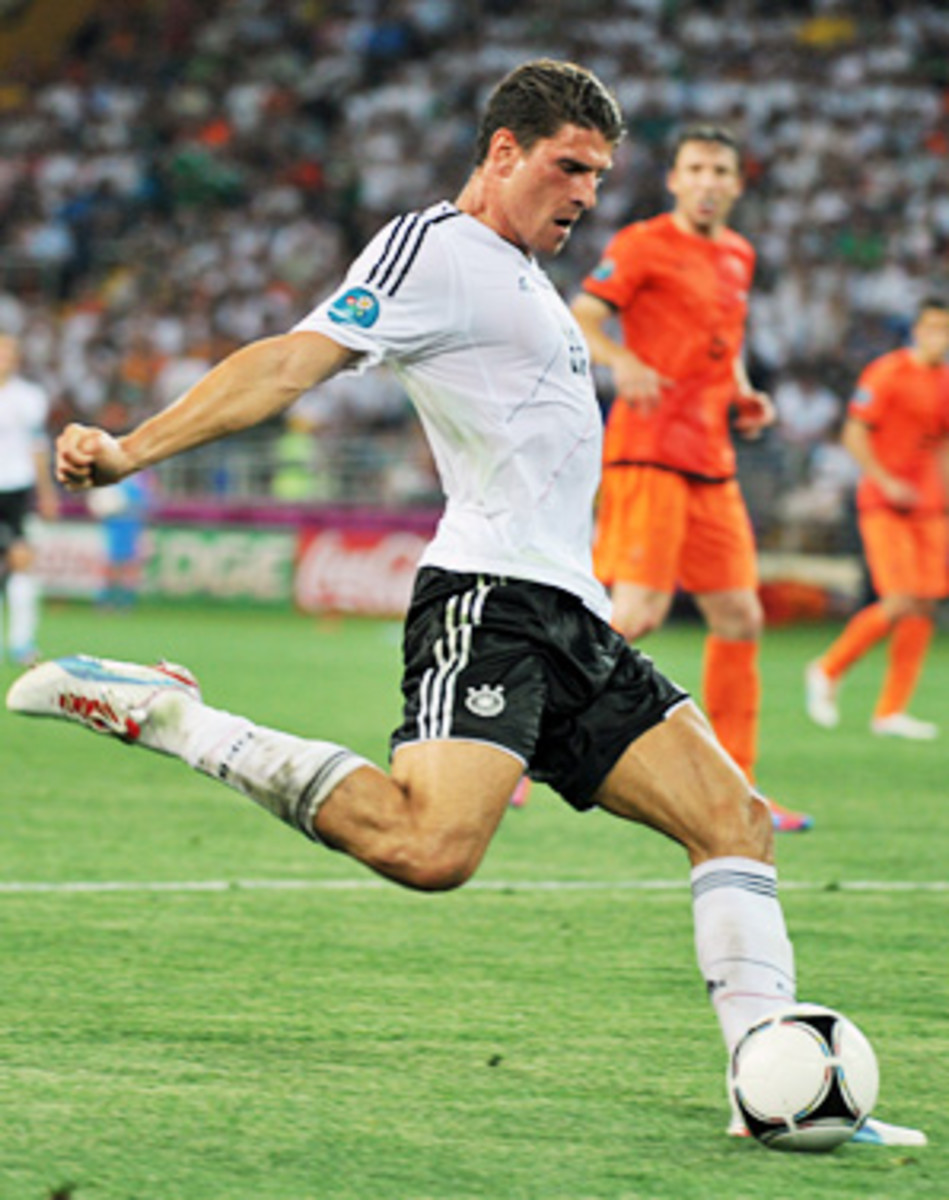Three thoughts: Gomez displays brilliance in Germany win vs. Dutch
Three thoughts from Germany's 2-1 victory over the Netherlands from Kharkiv, Ukraine.
1. Mario Gomez is a baffling footballer. There is a short story co-written by Jorge Luís Borges and Adolfo Bioy Casares called "Esse est percipi", in which the authors imagine that the Argentinian football that supposedly drew huge crowds in the 1930s didn't really happen. Instead, it was cleverly scripted and performed by a radio commentator. The matches were simply fabrications.
Likewise, there are some players who -- upon viewing them -- perform so radically different than their reputations that it makes fans wonder whether their careers were made up. And Mario Gomez was always one of them: His resemblance to George McFly from the Back to the Future series only added to the notion that he might actually be a character played by an actor (specifically, in this case, Crispin Glover). His stats looked terrific -- 24 league goals for Stuttgart in 2008-09, 28 for Bayern Munich in 2010-11, 27 in 2011-12 -- yet whenever he wandered into a big international match, he blundered around and missed chances with abandon. Was his skill in finding the positions? Was the Bundesliga that much easier than the Champions League? Against Real Madrid in the Champions League semifinal he missed four clear chances before finally bundling in a Phillip Lahm cross with his standing leg. Then, in the final, Gomez's profligacy was arguably the single biggest reason that Bayern didn't win.
TURNER: Euro 2012 Day 6 wrap
Somewhere along the line, however, Gomez and Petr Cech swapped form. Cech was imperious in Munich as Chelsea won the Champions League, but he has been error-ridden for the Czech Republic thus far in Euro 2012. Gomez, on the other hand, has been sensational. His headed winner against Portugal in the first game was good, but his two goals against the Netherlands were even better. For the first, he turned superbly onto Bastian Schweinsteiger's through-ball before sliding a slightly fortuitous finish past Maarten Stekelenburg. Yes, the shot went in off the keeper's shin, but the turn earned him some luck. The second was even more impressive, as Gomez ran onto another Schweinsteiger pass and took advantage of Stekelenburg going down a touch early to lash his shot high and just inside the far post.
HONIGSTEIN: Portugal-Denmark three thoughts
2. Nigel De Jong and Mark van Bommel were startlingly ineffective. De Jong and van Bommel were supposed to represent the ugly face of the modern Dutch game. They were supposed to be cynical, hard-tackling spoilers who protect the back four in a broken 4-2-3-1, winning balls so that the front four can convert on the other end. That was the pragmatic style that took the Dutch to the World Cup final two years ago. The canal belt intellectuals may not have liked it, and some even saw it as a betrayal of the Total Football tradition, but it was indisputably effective.
Not anymore. With Mesut Ozil dragging the pair back and forth and creating space, Bastian Schweinsteiger was able to find unfathomable amounts of space in what Ottmar Hitzfeld terms "the red zone", that is, the central area 10-20 yards outside the 18-yard box. It is the space that defenses must protect above all else -- Roy Hodgson has based a career on it -- and yet Schweinsteiger merrily picnicked there in the first half, having time to measure his through-balls to Gomez.
Whatever other problems plague the Dutch -- they may have moved away from the total-footballing 4-3-3 philosophy, but the traditional sulking, backbiting and infighting remain as popular as ever -- this basic structural error undermines everything else.
3. Germany's defense is unconvincing. The warning signs were there when Germany conceded three goals to Ukraine last November, and again when it surrendered five in a friendly against Switzerland earlier this month (although Germany was, admittedly, without its Bayern players for the latter game). When the Netherlands really applied pressure in the final 30 minutes, Germany looked distinctly wobbly. For all that Germany was the better side, it struggled in the back. With a few slightly more composed finishes or some loose balls bouncing the other way, the result could have been very different.
The makeup of the back four is slightly odd given that three of the four players compete for the same club, but two of them are slotted in different positions. Jerome Boateng is usually a center back for Bayern, but he plays at right back for Germany. Meanwhile, the Bayern right back, Philipp Lahm, plays at left back on the national squad. Only Holger Badstuber plays in his equivalent club position.
Just as problematic is the way that the two holding players played -- but that was the gamble Low took. By having Ozil drag the Dutch holders with Schweinsteiger and Sami Khedira moving into the space, Germany enhanced its attacking threat significantly. The downside, however, was that when the Dutch broke, the back four were left exposed. The area a holder should protect, the red zone, was precisely the space into which Robin van Persie accelerated before lashing in the sole Dutch goal. On this occasion the gamble worked. But future opponents could capitalize on that back-four vulnerability.






